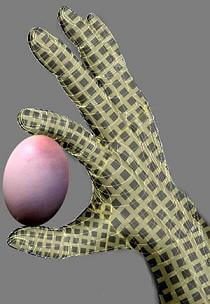
Even the coolest lab work is often years from practical applications. That’s what the media seemingly forgot in regards to recent developments in ‘artificial skin’. Researchers at UC Berkeley and Stanford have independently created thin layer sensors that can detect small changes in pressure. Both UC Berkeley and Stanford had their work published in Nature Materials and the two approaches to advanced pressure sensors have been covered by the BBC, Reuters, IEEE Spectrum, ABC, and the Wall Street Journal. The thin layer materials have been hyped as having sensitivity close to that of human skin and there’s been talk that they could provide the means for artificial skin for prosthetics or robots. While the work in these two projects is interesting, it’s many years away from any marketable projects and there are major hurdles they would have to clear before they could be used in the field in any application. Pragmatism, however, has been pushed aside in the glee over watching sensors detect a butterfly corpse and creating neat pictures of artificial skin gloves. Check out the video below to see what I mean. These are cool pressure sensors, but they aren’t skin-like yet.
Stanford’s sensor is composed of electrodes on either side of a thin film of rubber. These pressure sensitive layers have been constructed in the shape of tiny pyramids, allowing the sensor to spring back after being compressed. This has given Stanford’s material both extreme sensitivity and quick recovery. They’ve tested the system by detecting the weight of dead insects such as flies and butterflies. This has lead many media outlets to fill their stories with ideas that the sensor could let someone feel an insect land on their artificial limb. You can almost see how researchers in the video below are being lead to make these kinds of comments:
The work out of UC Berkeley is no less impressive for its accomplishments in energy use and flexibility. Their ‘e-skin’ sensor utilizes germanium and silicon nanowires to form a thin film transistor. This TFT runs on less than five volts, and can handle being bent 2000 times on small radii folds (<2.5mm) and still function. As its name implies, the e-skin has been considered as a means of providing human-like touch sensitivity for prosthetic limbs as you can see in the computer generated image from the lab.

Both of these projects are remarkable feats in sensor technologies, but I object to categorizing these sensors as artificial skin, especially for prosthetics. Such an association glosses over the limitations we have in connecting mechanical sensors to our nervous system. Even though these sensors can mimic the sensitivity of human skin under the normal range of human pressures (0-15 kPa or so) how are we going to transmit that information to your brain? Our most advanced sensing prosthetics handle just a few points of touch, not the hundreds or thousands of points that you’d associate with a full hand like one imagined in the image.
True, in the future we’re likely to be able to improve the way we connect mechanical/electrical signals to our brains. Or maybe we just want to use these types of artificial skins for robots, which have an all electrical ‘nervous system’ anyway. Well, even then, I’m worried that media coverage ignores how few of these sensors have actually been made. The Stanford sensor looks like a single hand made pressure cell. Even the UC Berkeley TFT is made in a fairly small array (7×7 cm with 18×19 pixels). Mass producing these sensors is not going to be trivial. We’ve seen projects for robot skin before, some of which, like the QTC sensors, have been under development for years. They’re still working on getting these systems ready for field work and real world applications.
You know, if headlines for these projects read “California researchers develop advanced pressure sensors” I probably wouldn’t be objecting at all. Heck, I’d probably have written my own effusively praising article that alluded to the idea that such sensors could one day be used in artificial skin for prosthetics and robots. But calling these projects ‘artificial skin’ right off the bat seems false to me, and a bad case of hype. Yes, these sensors may have human like sensitivity in the pressures they can detect, but that’s a far cry from actually being used to create artificial skin. I applaud both UC Berkeley and Stanford for their remarkable work in pressure sensors, but please don’t expect either of these projects to evolve into a marketable skin-like product for many years to come.
[image credit:Stanford University, UC Berkeley]
[source: Stanford News, Berkeley News; Takei et al and Mannsfeld et al, 2010 Nature Materials]


